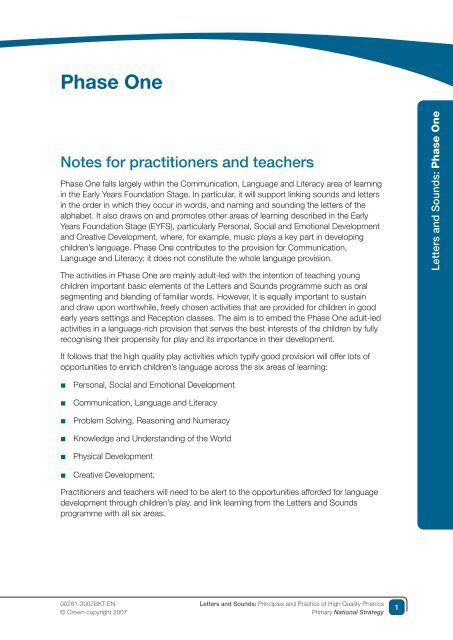Letters and Sounds 1
Letters and Sounds 1
Letters and Sounds 1
You also want an ePaper? Increase the reach of your titles
YUMPU automatically turns print PDFs into web optimized ePapers that Google loves.
Phase One<br />
Notes for practitioners <strong>and</strong> teachers<br />
Phase One falls largely within the Communication, Language <strong>and</strong> Literacy area of learning<br />
in the Early Years Foundation Stage. In particular, it will support linking sounds <strong>and</strong> letters<br />
in the order in which they occur in words, <strong>and</strong> naming <strong>and</strong> sounding the letters of the<br />
alphabet. It also draws on <strong>and</strong> promotes other areas of learning described in the Early<br />
Years Foundation Stage (EYFS), particularly Personal, Social <strong>and</strong> Emotional Development<br />
<strong>and</strong> Creative Development, where, for example, music plays a key part in developing<br />
children’s language. Phase One contributes to the provision for Communication,<br />
Language <strong>and</strong> Literacy; it does not constitute the whole language provision.<br />
The activities in Phase One are mainly adult-led with the intention of teaching young<br />
children important basic elements of the <strong>Letters</strong> <strong>and</strong> <strong>Sounds</strong> programme such as oral<br />
segmenting <strong>and</strong> blending of familiar words. However, it is equally important to sustain<br />
<strong>and</strong> draw upon worthwhile, freely chosen activities that are provided for children in good<br />
early years settings <strong>and</strong> Reception classes. The aim is to embed the Phase One adult-led<br />
activities in a language-rich provision that serves the best interests of the children by fully<br />
recognising their propensity for play <strong>and</strong> its importance in their development.<br />
It follows that the high quality play activities which typify good provision will offer lots of<br />
opportunities to enrich children’s language across the six areas of learning:<br />
■ Personal, Social <strong>and</strong> Emotional Development<br />
■ Communication, Language <strong>and</strong> Literacy<br />
■ Problem Solving, Reasoning <strong>and</strong> Numeracy<br />
■ Knowledge <strong>and</strong> Underst<strong>and</strong>ing of the World<br />
■ Physical Development<br />
■ Creative Development.<br />
Practitioners <strong>and</strong> teachers will need to be alert to the opportunities afforded for language<br />
development through children’s play, <strong>and</strong> link learning from the <strong>Letters</strong> <strong>and</strong> <strong>Sounds</strong><br />
programme with all six areas.<br />
00281-2007BKT-EN<br />
© Crown copyright 2007<br />
<strong>Letters</strong> <strong>and</strong> <strong>Sounds</strong>: Principles <strong>and</strong> Practice of High Quality Phonics<br />
Primary National Strategy<br />
<strong>Letters</strong> <strong>and</strong> <strong>Sounds</strong>: Phase One
















